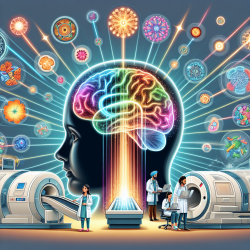Introduction
Inborn errors of metabolism (IEMs) are a group of genetic disorders that disrupt normal metabolic processes, often leading to severe neurological impairments. Recent advancements in neuroimaging technologies have opened new avenues for diagnosing and managing these conditions. As practitioners dedicated to improving outcomes for children, it's essential to stay abreast of these innovations and consider their application in clinical practice.
The Power of Advanced Neuroimaging
Traditional MRI techniques, while valuable, often fall short in detecting the nuanced changes associated with IEMs. Novel imaging modalities such as Diffusion Tensor Imaging (DTI), Magnetic Resonance Spectroscopy (MRS), and functional MRI (fMRI) offer deeper insights into the brain's structure and function. These technologies can reveal microstructural abnormalities, metabolic disruptions, and functional connectivity issues that standard MRI might miss.
Diffusion Tensor Imaging (DTI)
DTI is particularly useful for mapping white matter integrity. For instance, studies have shown that children with Galactosemia exhibit reduced white matter volume and altered neural pathways compared to healthy controls. Similarly, DTI has revealed widespread white matter disturbances in patients with Methylmalonic Acidemia, providing a more comprehensive understanding of the disease's impact on brain structure.
Magnetic Resonance Spectroscopy (MRS)
MRS allows for the non-invasive measurement of brain metabolites, offering valuable insights into the biochemical environment of the brain. For example, in Maple Syrup Urine Disease (MSUD), MRS can detect elevated levels of branched-chain amino acids, which are indicative of the disorder. This information can guide therapeutic interventions and monitor disease progression.
Functional MRI (fMRI)
fMRI is instrumental in understanding the functional impact of IEMs on cognitive processes. Research has shown that children with Phenylketonuria (PKU) exhibit altered neural activity during tasks requiring executive function. This knowledge can inform targeted cognitive therapies aimed at mitigating these deficits.
Practical Applications and Future Directions
Integrating these advanced imaging techniques into routine clinical practice can significantly enhance diagnostic accuracy and treatment efficacy. Practitioners should consider the following steps:
- Stay Informed: Keep up-to-date with the latest research and technological advancements in neuroimaging.
- Collaborate: Work closely with neuroimaging specialists to interpret complex imaging data and integrate findings into treatment plans.
- Advocate: Advocate for the availability of advanced imaging technologies in clinical settings to ensure all patients have access to the best diagnostic tools.
- Research: Engage in or support further research to explore the full potential of these technologies in understanding and treating IEMs.
Conclusion
Advanced neuroimaging technologies hold great promise for improving the diagnosis and management of inborn errors of metabolism. By embracing these innovations, practitioners can make more informed, data-driven decisions that enhance outcomes for children affected by these complex conditions.
To read the original research paper, please follow this link: Novel imaging technologies for genetic diagnoses in the inborn errors of metabolism.










